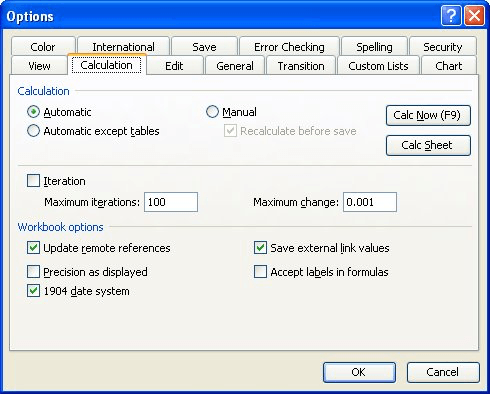Please Note: This article is written for users of the following Microsoft Excel versions: 97, 2000, 2002, and 2003. If you are using a later version (Excel 2007 or later), this tip may not work for you. For a version of this tip written specifically for later versions of Excel, click here: SUMIF Doesn't Recalc Automatically.
Written by Allen Wyatt (last updated June 23, 2018)
This tip applies to Excel 97, 2000, 2002, and 2003
Johan wrote about a problem he was having with the SUMIF function in his worksheet. It seems that when the data in his worksheet changes, the SUMIF function doesn't automatically update. He is, however, able to update the formula if he selects it, presses F2 (to jump into edit mode) and then press Enter.
The first, easiest, and most obvious thing to check is whether you have automatic calculation turned on. Follow these steps:

Figure 1. The Calculation tab of the Options dialog box.
If this does not fix the problem, then it must be related to the actual SUMIF formula. For instance, you may think that the data you are changing in the worksheet is actually referenced in the SUMIF formula, but it may not be. (If it isn't, then changing the data won't change the formula results.) Check the formula to make sure that it covers the proper range.
Remember, as well, that if your worksheet is large and complex, and the SUMIF formula is in a cell that is above your data table, it is possible that you may need two calculation passes to update the SUMIF function. Why? Because when you calculate a worksheet, Excel basically calculates the cells from left to right and top to bottom. If you have a very large worksheet, with lots of dependent calculations, and the calculations on which everything else is dependent are at the bottom or right side of the worksheet, then you may get incorrect results for the SUMIF function. (This happens only with the most complex of worksheets.) The answer is to reorganize your worksheets so that the primary calculations are placed near the top of the worksheet and as far left as possible, and the calculations that are based on those primary calculations are placed later in the worksheet.
ExcelTips is your source for cost-effective Microsoft Excel training. This tip (3069) applies to Microsoft Excel 97, 2000, 2002, and 2003. You can find a version of this tip for the ribbon interface of Excel (Excel 2007 and later) here: SUMIF Doesn't Recalc Automatically.

Professional Development Guidance! Four world-class developers offer start-to-finish guidance for building powerful, robust, and secure applications with Excel. The authors show how to consistently make the right design decisions and make the most of Excel's powerful features. Check out Professional Excel Development today!
When preparing financial reports, it may make your data easier to understand if you round it to the nearest multiple, ...
Discover MoreWant to round values so they are always even or odd? You can do it quickly and easily by using the EVEN and ODD worksheet ...
Discover MoreNeed to find the absolute value of a number? That's where the ABS function comes into play.
Discover MoreFREE SERVICE: Get tips like this every week in ExcelTips, a free productivity newsletter. Enter your address and click "Subscribe."
There are currently no comments for this tip. (Be the first to leave your comment—just use the simple form above!)
Got a version of Excel that uses the menu interface (Excel 97, Excel 2000, Excel 2002, or Excel 2003)? This site is for you! If you use a later version of Excel, visit our ExcelTips site focusing on the ribbon interface.
FREE SERVICE: Get tips like this every week in ExcelTips, a free productivity newsletter. Enter your address and click "Subscribe."
Copyright © 2026 Sharon Parq Associates, Inc.
Comments